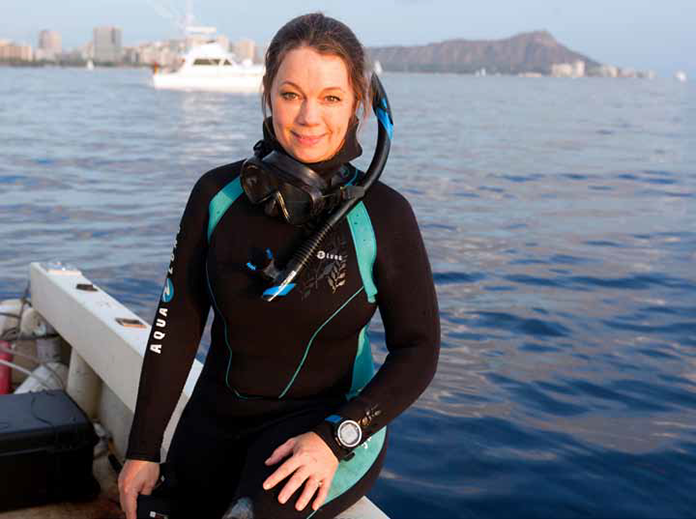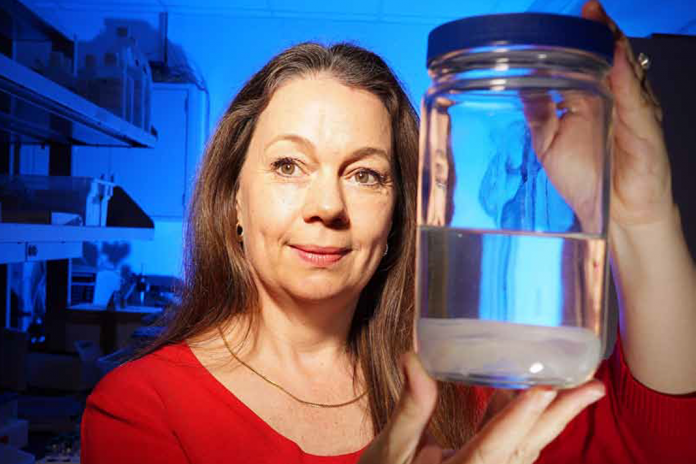Nothing can ruin a day at the beach as quickly as a jellyfish sting. Ask biochemist Dr. Angel Yanagihara; she had a nasty first encounter years ago in Waikiki that left her unconscious as soon as she reached the shore. While the incident was one she hopes to never experience again, it was also what sparked her passion for studying these creatures to become Hawai‘i’s jellyfish expert. Her research is a breakthrough in understanding box jellies and how to treat their stings, which comes as much relief for today’s beachgoers.
Mahalo for talking story with Makai! So tell me a little about yourself. What brought you here to Hawai‘i?
I was born in Anchorage, Alaska. We moved every few years since my father was an Air Force officer in the Strategic Air Command, but my first memories are of Alaska and our family time there camping, fishing, boating and enjoying the snowy winters. I graduated from the University of Virginia (BA Chemistry, BA Biology) and then entered the PhD program in Biochemistry at Georgetown University. After completing 5 years of research and all the required coursework at Georgetown, a family move led me to transfer to the University of Hawai‘i, where I continued my research and received a PhD in Cellular, Molecular and Neuro Sciences.
Wow! Sounds like you’ve accomplished a lot. Would you mind telling us about your first encounter with a box jelly years ago?
July 29, 1997 was the ninth day after the full moon. Earlier in the week, I had defended my PhD dissertation and was looking forward to summer graduation, when I headed to Kaimana Beach for my usual early-morning open-ocean mile-long swim. A woman walking along the beach pointed out clear, tiny, three-inch blobs and warned me not to swim, telling me that there were “box jelly-fish.” I had never heard of “box jellyfish,” and I thought they looked more like harm-less salps than jellyfish. I also had on a lycra “shorty” and thought that I should be fine if I were to encounter these flimsy-looking critters.
But an hour later, on my way back in from my swim, I was stung over my neck, arms and legs by something that seemed stringy but invisible near the windsock. I started to gasp and wheeze and had great difficulty swimming back to shore. I lost consciousness after making it to the beach.
Oh no! That sounds like a terrible experience.
After three agonizing days of horrible pain, which no medication or cream seemed to help, I wanted to know more about “box jellyfish” and especially about their horrific venom. I did a basic literature search for publications on the biochemical characterization of the box jellyfish venom and was surprised that almost nothing was known. Fortuitously, the grant application deadline for the Hawaii Community Foundation was just around the corner, so I submitted a proposal to do this work. To my great surprise, as I had never worked in the field of marine biochemistry or venoms, my application was funded. My basic training as a Photo Courtesy Laura Aguon biochemist led me to suggest fundamental research approaches. This first grant al-lowed me to do “pioneering,” “hypothesis-generating” work that led to the first bio-chemical characterization data. From those results, I composed further grant objectives and again submitted these approaches for consideration for new funding.

After 17 years as a “soft-money,” or grant-funded, researcher with no direct UH sup-port, I have brought in over $4.2 million in investigator-generated extramural funding (with about 35% of the overhead generated going to UH). This has allowed me to build a world-recognized research program and to make many valued discoveries. I am most pleased to have developed technologies, now in use by the United States Special Forces Combat divers, for the treatment of box jellyfish stings.
Awesome! What were your findings?
By way of general background, many jellyfish stings are known to lead to immediate burning pain and can result in itchy welts or scars. It was also known that box jellyfish stings can result in serious systemic responses, including death.
My work has shown that the venom contains hole-punching or pore-forming toxins that are structurally similar to anthrolysin O, the pore-forming toxin produced by anthrax. My work also demonstrates that the box jelly sting is not like a bee sting. The amount of cellular rupture is more than 10 thousand times that of a bee sting. The venom acts more like snake venom and causes cellular destruction. Specifically, red blood cells, platelets and white blood cells are lysed. This causes a high rise in plasma catecholamines, histamine and cytokines. Altogether, this presents a complicated clinical outcome that looks more like bacterial sepsis.
What this means is that the immediate reaction is not at all an “allergy” or “allergic reaction,” which require previous exposure and are driven by our body’s own IgE (immunoglobulin E, a class of antibody that plays a role in allergic conditions such as anaphylactic reactions). Again, since box jellyfish venom contains these pore-forming proteins that act very quickly to break open blood cells and is not an IgE based allergy, use of an EpiPen (for injecting epinephrine or adrenaline to treat serious allergic reactions) is not appropriate.
My work has also shown that hot water immersion is the best first-aid approach. This work has been repeated and confirmed by many others around the world. What does not work, though, are ice packs. Unfortunately, ice packs are easy for lifeguards and first responders to keep on hand and they are actually being used in Honolulu, despite the fact that they are not useful in box jelly-fish stings and can ultimately lead to longer lasting and more serious symptoms.
Good to know. As kids, my dad would rub meat tenderizer or apply vinegar to our stings. Were those just myths?
Double-blind controlled studies and retrospective studies have shown that hot water immersion is the most effective emergency treatment. Laboratory work demonstrates that the venom porin (a pore-forming toxin in all coral, anemone and jellyfish venoms and especially potent in box jellyfish venom) is irreversibly inhibited by heat.
First flooding the site with vinegar or Epsom salt-saturated water can remove tentacles and non-discharged cnidae from the sting site. Urine is considered a “do no harm” approach as it is mildly acidic and warm, but it actually does cause some additional cnidae discharge. Cold, freshwater is not helpful and can cause more stinging cells to discharge. (As mentioned earlier,) ice packs are perhaps the worst approach, as the pressure will increase the discharge, and the ice will only temporarily slow the venom action. Once the tissue warms again in the area, since the venom is still in the skin, it will continue to act and the sting victim may now be out of sight of the caregiver. Alcohol or Dermaplast (pain relief spray) should never be used as these cause massive cnidae discharge, which is the explosive release of sting-ing cells tubules that inject venom into the skin.

Would you say your findings were “groundbreaking”? How can everyday swimmers/surfers/watermen benefit from your research?
Science moves slowly and methodically, but if I were to condense the findings of 17 years of work at UH, I am happy to say that these studies have led to many “groundbreaking” discoveries.
1) First of all, we discovered that the venom doesn’t work like a “silver bullet” ion channel blocker or like a bee sting as had been previously thought but works more like toxic bacteria. This is rather ingenious biological strategy, though, because these ancient bacterial-like proteins, called porins, act like buckshot, forming holes in all the cells the venom touches. 2) My efforts then focused on how to stop this “buckshot”-like pro-tein. Another groundbreaking discovery was that certain metal ions rapidly inhibit porins. This led me to develop my patent pending Sting No More™ formulations. This is now being made in a topical form for Special Operations Combat divers who routinely encounter both box jellyfish and Man-o-War. 3) A further important discovery is that the venom causes cellular destruction of red blood cells, platelets and white blood cells and that the porin can cause a very high life-threatening rise in plasma catecholamines, histamine and cytokines. Altogether, this presents a complicated clinical outcome that can look like bacterial shock. 4) The immediate reaction is not at all an IgE “allergy” or “allergic reaction.” Again since box jellyfish venom contains these pore-forming proteins that act very quickly to break open blood cells causing spikes in blood pressure and is not IgE-based allergy; use of an “epipen” is not appropriate. 5) Because my basic work requires lots of the raw material or box jelly venom, since 1997, my lab members and I have to be on the beach each month from about 2-6 a.m. during the jellyfish influx days. This led us to taking careful records of the numbers and times and conditions of the animals. This data set has become the oldest continual data set in the world related to box jellyfish and has allowed us to understand triggers and discover critical aspects of box jellyfish life cycle. 6) Basic biochemistry of the venom and the animal has also led to pivotal discoveries in biomaterials and vision.
How is your sting treatment applied and how often? Is it available commercially?
My technologies can be applied in various formats and can be used before swimming or after a sting. It is not yet available commercially but will be soon.
How serious are box jelly stings?
Up to 1,000 ambulance calls have been attributed to box jellies in a single month (July 1997, Honolulu Advertiser). It is hard to estimate the number of total stings but based on our data with an average number of box jellies of 500/month in a 400-meter-long section of Waikiki Beach, that could indicate about 10,000 box jellies come ashore per month or 120,000 per year. Given the numbers of swimmers, 5,000-50,000 stings a year might occur. There are at least four deaths worldwide from the type of box jellyfish we see here. These deaths involved complex medical sequelae called Irukandji syndrome. There have been hundreds of Irukandji cases in Hawai‘i, but few, if any, deaths directly due to this syndrome. There are over 30 species of box jellies. Most deaths are caused by much larger species of box jellies in the Chirodropid family with a range that extends from Australia to Vietnam.
I’m interested to hear about your role with the U.S. Special Forces, as well as extreme swimmer Diane Nyad.
I was contacted about five years ago, when a U.S. Special Operations Command (US-SOCOM) combat diver was stung by an unknown stinger near Key West, Florida and developed life-threatening Irukandji symptoms. Since then, I have been work-ing with the Dive Medical Officers there to provide research-based technologies
to address the serious stings. I have also conducted on-site, night-time fieldwork involving extensive scuba surveys. We have been able to capture and identify several box jellyfish in the training areas. I was awarded a contract from USSOCOM to continue this work and to provide this treatment to combat divers.
Diana Nyad contacted me by email, out of the blue, asking me about box jellies. After I “Googled” her name and watched her TED talk online, I was fully motivated to try to be of assistance. She followed up with an email telling me of her horrific experiences in trying to swim from Havana, Cuba, to Key West, Florida. She asked me for a preventative cream. I told her that I did not know that such a thing was possible, but I developed a sting treatment that could be applied underwater. I then worked with her and her team and participated in both the 2012 swim and the successful 2013 swim as her jellyfish expert and night free diver.
Any tips for our readers on how to avoid getting stung by a box jelly or any jellyfish?The best tip for either stinger is to stay out of the water if there are jellies on the beach! The next best tip to avoid box jellies is to avoid leeward O‘ahu beaches during the mornings and evenings of the 8-10th days after each full moon. Additionally, wearing Lycra long-sleeve rash guard can protect the arms or a full body exposure suit will protect the body from either stinger.
How else are you involved in the ocean/marine life community?
Currently, I am involved in field research in Puerto Rico, Saipan, Florida and Bonaire. This involves pelagic night scuba and free-diving, as well as photographing and collecting pelagic invertebrates. For recreation, I love sailing, ocean swimming, scuba diving and underwater photography.
Is there anything else you wanted to add?
Misinformation around jellyfish stings is a huge issue with all sorts of “expert” advice that is not validated by independent research. There are even published results that have not been replicated leading to confusion, such as the new claim that vinegar is now potentially harmful, despite 40 years of beneficial use around the world. I am concerned about the critical need to improve public safety awareness and first responder care right here in Hawai‘i. The scientific and medical literature is clear: ice packs should never be used for box jellyfish stings. It is also important not to rub or scrape the sting site. Vinegar sprays with hot water immersion or Epsom salt-saturated hot water immersion are validated approaches.
Also, feel free to visit my site for more information, https://manoa-hawaii.academia.edu/AngelYanagihara.








